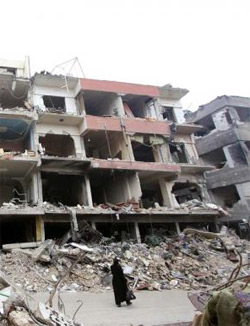
Pregnant women exposed to chemical weapons during the August 2013 attack in Syria were much more likely to miscarry or deliver prematurely, new findings show.
The study also found a high rate of serious birth defects among babies whose mothers had been exposed to poison gas. “This is a starting point, and I hope that it opens the door for way more research and study,” Dr. Sawsan Jabri, one of the study’s authors, told
Reuters Health in a telephone interview.
On August 21, 2013, the Syrian government launched a chemical attack against rebel strongholds outside Damascus, which killed more than 1,600, according to Dr. Jabri, who is a candidate for a master’s degree in public health at Johns Hopkins Bloomberg School of Public Health in Baltimore.
While the chemical used in the attack has not been identified, Dr. Jabri said, sarin is the most likely candidate.
Dr. Jabri and Dr. Omar Hakeem of Al Ghouta Hospital in Damascus wrote online February 23 in The Lancet Global Health, “While the acute exposure resulted in several deaths, the long-term consequences are still unfolding.”
The two researchers reviewed medical records for 211 pregnant women who visited Al Ghouta Hospital in the fall of 2014, including 110 who said they’d been exposed to the chemical attack.
Forty-five percent of exposed women miscarried, compared to 14 percent of the unexposed women.
The rate of stillbirths among the exposed group was 27.2 per 1,000 births, Dr. Jabri and Dr. Hakeem note, compared to a rate of 12.4 per 1,000 for Syria in 2009.
Globally, about three of every hundred babies has a congenital abnormality or birth defect, the authors note. Among the 110 exposed women, seven had newborns with serious malformations, and five of the infants died within a few days. One of the two surviving infants had cardiac abnormalities while the other had cerebral edema.
“Clinical findings among the babies who died included multiple malformations of the head and spinal cord, absence of the occipital and parietal bones of the skull, small brain size with a large amount of fluid between the skull and scalp, dissecting skin in many areas of the body, and many clots in the umbilical cord,” the authors write.
Dr. Jabri and Dr. Hakeem hope to collect data on birth outcomes from other hospitals serving areas affected by the chemical attack. One issue that needs to be studied, she added, is how much of the chemical remains in the environment and in the groundwater, which could affect generations to come. “It’s very, very hard to tell,” she said.
The initiative has now set its sights on ending all preventable deaths of women and children.
“We need to look for new partnerships and new funding mechanisms,” Solberg said.